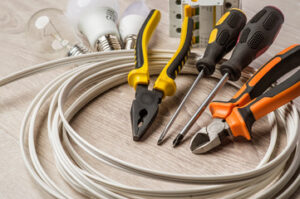Your roof is your silent guardian, shielding you and your family from the elements. Homeowners must understand roofing, from identifying and performing minor repairs to planning re-roofing projects.
Rafters, joists, and trusses provide the framework that supports your roof. Sheathing, made from plywood or oriented strand board, encloses the framework and protects it from weather damage. Click https://www.roofersincolumbusga.com/ to learn more.

A flat roof is a type of roofing that has a minimal slope, typically less than 10 degrees. This style of roof is often found in commercial buildings and has several different materials that can be used for its construction. Some of the most popular types of flat roof material include EPDM, TPO, and PVC. These types of roofs are durable and resistant to UV rays, ozone, and extreme temperatures.
Due to the nature of their low slope, flat roofs require a specific kind of roofing material that has the capacity to hold water and snow. The roof’s surface also needs to be able to handle heavy winds. While flat roofs have their own advantages, they can present challenges that can be difficult to overcome.
While they may look unattractive, a properly designed and maintained flat roof can be just as functional as a sloped roof. This is because they can offer additional usable space and are often easier to access for maintenance and repairs.
However, many flat roofs have drainage problems that can result in water ponding and other serious damage. This is often caused by poor maintenance, which allows leaves and other debris to block the roof’s drain outlets. As the water accumulates, it creates a high-pressure head that can crack or puncture the roof membrane.
To prevent this from happening, a flat roof should be regularly inspected and any deteriorating areas should be repaired as soon as possible. It is also important to have a good waterproof sealant that will prevent the formation of leaks.
Membrane flat roofs are a great choice for many homeowners and business owners as they come in sheets that can be rolled onto your existing roof. They are usually made of rubber or synthetic materials and can be very energy efficient, as they have a high level of reflectivity.
While turning a flat roof into a garden space is a great idea for eco-friendly living, it can cause issues with the growth of invasive plant roots that can penetrate the roof and cause leaks. This is a problem that can be easily prevented by working with an experienced and professional roofing contractor who understands the challenges of flat roof design and installation.
Sloped Roof
The slope of a roof, often referred to as the pitch, plays a significant role in water drainage, structural integrity and aesthetics. It’s important for homeowners to understand why, how and when roof slopes are chosen, as well as how to accurately measure their own roof’s pitch. This will ensure a quality roof that safeguards your home from natural elements for years to come.
The most common type of residential roof is a steep-sloped one, which accounts for around 90% of all homes. This style is preferred for a number of reasons, including its beautiful appearance and performance. Unlike flat roofs, a sloping roof promotes effective drainage by preventing water from pooling on the surface. Water that pools on a roof can cause moisture buildup, which then leads to leaks and mold. This is why it’s so important to work with a roofing contractor that is familiar with the nuances of this type of roof.
There are a number of different options for roof slopes, and the type that is best for your home depends on many factors, such as the climate in your area and your personal preferences. For example, homeowners in areas that experience frequent snowfall typically opt for a steeper roof pitch that will shed snow more quickly and reduce the risk of water damage.
A sloping roof also has the benefit of allowing for better ventilation in the attic, which is an important factor when it comes to reducing moisture buildup. A properly ventilated attic also helps homeowners to save on energy costs by allowing warm air to escape during the summer and cold air to escape during the winter.
When it comes to choosing the right material for a sloping roof, the most common choice is asphalt shingles, which offer a wide range of color and design options and are easy to install. Other options include wood, which offers a more rustic aesthetic and is durable but requires extensive maintenance, or metal, which provides an attractive, long-lasting finish that’s highly weather resistant. If you choose to go with a sloping roof, it’s vital that you work with an experienced roofing contractor who can help you select the appropriate materials for your home.
Shingle Roof
A shingle roof is one of the most common types of roofs and it protects your home with layers of different materials that work together in a specific design to keep water out. This type of roofing can come in many different colors and textures that allow you to tailor your house’s look. Some shingles are made from wood, clay, slate, and even plastic. The shingles themselves are a key element to the overall function of the roof because they shed the water in a specific way, directing it down into gutters that can whisk it away from the house.
Shingles are one of the most popular roofing options because they’re cost-effective and versatile. They can be crafted to mimic the look of cedar shake shingles, old-style slate roofs, or even traditional asphalt shingle designs. They’re also available in a wide range of color options, making them an attractive choice for many homeowners.
The strength of shingles depends on their composition. A fiberglass base mat, for example, serves as a robust foundation, while the asphalt layer on top prevents moisture from infiltrating your home. Added ceramic granules augment the aesthetic, and they’re effective at shielding your roof from UV rays and extreme temperatures.
While they’re a popular option for many homeowners, there are some shingle types that may have better longevity than others. Clay tile shingles, for instance, provide classic curb appeal and can last for 50 years or more. However, they’re a heavy roof material that can add structural stress to your home over time and require higher insurance premiums than other shingle types.
All shingle roofing options provide excellent protection for your home, but the shingle type you choose should be considered in relation to your budget and how long you want your roof to last. While a natural slate roof may cost more up-front, it’ll typically last twice as long as an asphalt shingle roof and can save you money in the long run.
Your roof is the most important protective element of your home, so it’s essential to ensure that it’s in good condition. A regular schedule of maintenance is critical to extending the life of your shingles and to protecting your entire home from leaks, rot, and other costly issues.
Metal Roof
Metal roofs are becoming increasingly popular with homeowners, as they offer durability, longevity and energy-efficiency that surpasses traditional roofing materials. These durable roofs are known to resist almost anything that Mother Nature can throw at them. They are highly resistant to fire, have an impact resistance that is usually rated at Class 4, and can withstand hurricane-force winds and wind-driven debris.
A metal roof can also be designed to provide insulation, which can help reduce energy consumption and costs and make your building more comfortable for occupants. This is because metal is highly conductive, and without proper insulation, it can allow heat or cold to transfer easily from the outside to the inside of your building. Insufficient insulation also increases the amount of condensation that occurs, which can lead to mold and mildew issues.
The level of maintenance needed for a metal roof is typically minimal, especially if the roofing material is standing seam or concealed fastener. However, a screw down panel metal roof will require regular replacement of screws, which can become loose or wallow out over time. It is recommended to have a metal roof cleaned at least once a year or after strong storms.
While metal roofs have a higher upfront cost than other roofing materials, they often recoup their cost by reducing energy costs and increasing property value. They are also extremely durable and long-lasting, which can save you money in the long run by avoiding frequent repairs or replacements.
Many different types of metal roofing are available, with the most common being steel and aluminum. Aluminum is more lightweight than steel, but still offers the same structural strength, and is rust-resistant. Steel is the heaviest option, and can withstand extreme weather conditions, but requires more maintenance than aluminum.
A metal roof can be made to look very stylish, with a variety of options for colors and finishes. Some metal roofing can even mimic the appearance of shingles, clay tile and other styles of roofing. They can be painted with high-performance coatings that can help prevent chalking, fading and chipping.





